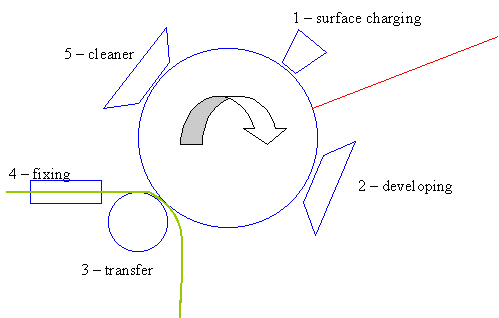
Lasers in Printers and Computers
In this section we will look at how laser printers and a variety of computer media such as CDs and DVDs work as well as take a look at the future of optical computing. We all use lasers in a variety of ways in our daily lives. Perhaps the most common and simplest use of diode lasers is as remote controllers for electronic equipment. Infrared diode lasers are used to control televisions, stereo players and other equipment. The wide beam divergence of the diode laser is an advantage in this case since you don't need to point the remote directly at the detector on the TV or stereo in order to have the signal be detected.
Laser printers are now commonly used for fast, reliable and clear copying - also in color. Laser printers work in a very similar way to xerox copying machines. The basic element is a rotating drum that has a very thin photosensitive coating. Usually the drum is light-weight aluminum and the active photosensitive material is either cadmium sulfide or selenium, coating the drum surface. This layer is then protected with a transparent non-electric conducting coating. In the sequence of events to print a page, first, the surface layer is charged up. Then, wherever light strikes the photosensitive surface, it becomes conducting and the charge rapidly leaks off those regions, leaving an image of the light pattern that is not visible but is recorded in where there is electric charge. Next, at the developing station as the drum rotates, toner is sprayed onto the drum. Toner is made of small, black, charged plastic particles, electrically charged with the same sign of charge as the original drum charge. The toner will stick to the drum only in the regions that were neutralized when hit by light; on the other regions, the static charge with the same sign repels the toner particles. Now there is a pattern of light and dark (in reverse- the darker toner is where the light struck). Next, a sheet of paper (green in the figure) is charged oppositely to the drum/toner charge and is fed onto the drum at the transfer station. The charged toner sticks to the paper - opposite charges attract - and the paper now has an image that is made more-or-less permanent by heating it to fuse the toner to the paper. See the figure showing the 5 basic components.

This same fundamental process is used in xerography and laser printers with the only major difference being how the light is generated. In xerography a bright white light is used to get a reflected image of the original paper while in laser printing, a modulated He-Ne or diode laser is used to do the actual writing. As shown below, the beam is modulated and deflected onto the drum in order to do the writing. The rotating mirror scans the beam back and forth across the page while the modulator scans the beam up and down as well as modulates its intensity. Color printing is done using a three-color toner system to mix and produce a large array of colors.
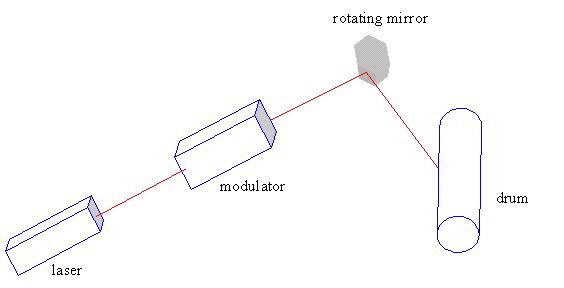
Optical disks include CDs, videodisks, DVDs, and other types of data storage for computers that are read optically using lasers. They are collectively characterized by a high density of information storage and non-contact reading and writing. Here we will discuss how information is written, stored, and read out.
In one type of storage, used in non-erasable CD-ROMs (Read-Only-Memory) the information is coded in a series of physical "pits" made on the surface of the disk using a focused laser beam and arrayed in a continuous spiral track. These pits are not erasable since they have been made by ablation using the laser. In coding digital information on CDs, the pits are all uniform in depth and carry the digital information for a 0 bit while the lack of a pit indicates a 1 bit. Error rates in the writing of the information are extremely low, typically less than one error in 1012 bits. The pit sizes are very small - on the order of 0.5 mm, about the wavelength of the laser light. A CD can hold about 700 million bits (Mb) of digital information, a DVD (Digital-Video-Disk) about 4.7 billion bits (Gb), while a double-sided DVD can hold about 17 Gb, enough for about 4 full-length videos, or about 4 million pages of text.
When a non-erasable optical disk is made, a master disk is created first using the scheme shown below. The laser beam is modulated, steered and brought to a focus so as to ablate the photoresist material as the master disk is rotated. Pits can be created at rates of millions per second.
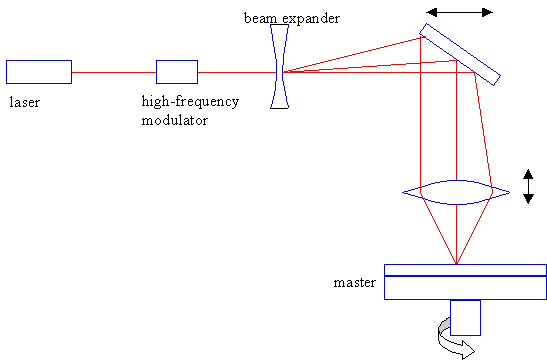
Once the master disk is created, stampers are created by making negative relief molded disks, so that where there is a pit on the master, there is a "hill" on the stamper (see the figure). These stampers are then used as molds to mass produce cheap plastic disks by injection molding liquid plastic to re-create the pits on its surface.
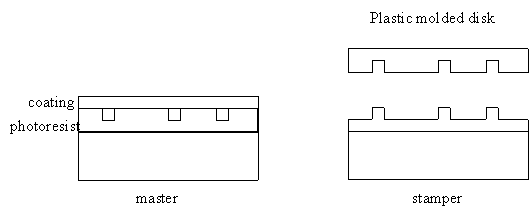
Read-out is accomplished using a simple optical scheme with an inexpensive diode laser to examine the reflections from the surface of the disk as it is rotated.
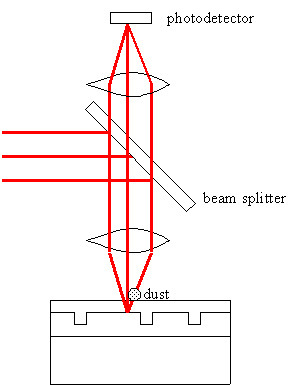
Note that because the laser is focused at the level of the pits, any dust or scratches on the surface of the protective outer plastic layer will have a minimal impact on the amount of reflected light detected at the photodetector since they will not scatter much light.
Reviewing the overall process, we see that a single master is made from which stampers can be made as needed, each one used to mass produce cheap plastic molded disks that are images of the original master disk. Now that we have some idea of how a non-erasable optical disk is made how do rewrite-able disks work? They obviously can not use the same process because there is no way to re-fill the tiny pits that were made in the above scheme. There are currently two different schemes in use for rewrite-able disks, each using special properties of a thin film coating on the disk. One technology uses magneto-optical recording which uses a thin film with molecules that can be oriented by a magnetic field. At normal temperatures these magnetic "domains" or small regions of magnetically lined-up molecules, are stable and keep their magnetic properties. When the laser heats the film locally to a high enough temperature, the molecules can be magnetically re-oriented so as to change the information content locally and thus re-written. This process is sensitive to large stray magnetic fields and so one needs to be careful in handling the disks. A second technology uses optical phase changes to record the 1 or 0 bits. The thin film material is made either in a crystal or amorphous state by interaction with either a high or low powered writing laser beam. The reflectance from these two different states is different and codes for the digital information. An advantage of this technology is that the disks are not sensitive to magnetic fields or static electricity and are long-lived.
Web Link on Optical Disks
Questions on Lasers in Printers and Computers
